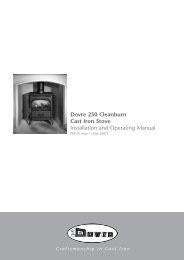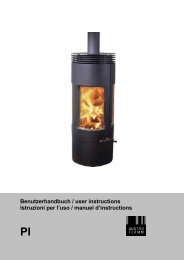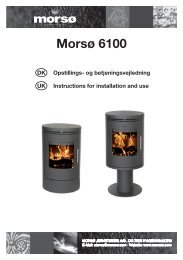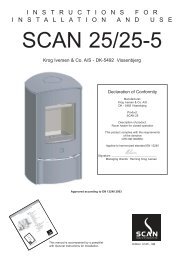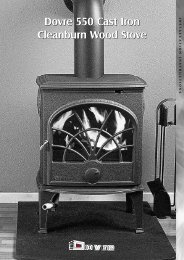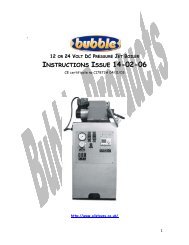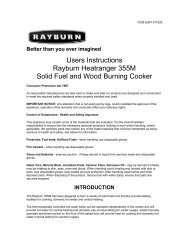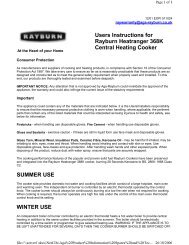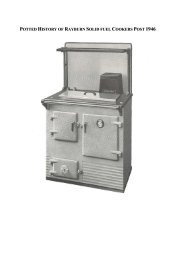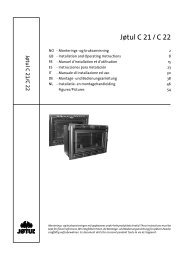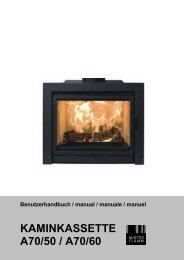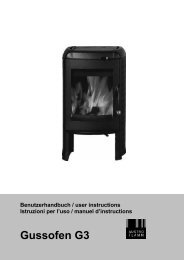Jøtul F 370 Series
Jøtul F 370 Series
Jøtul F 370 Series
Create successful ePaper yourself
Turn your PDF publications into a flip-book with our unique Google optimized e-Paper software.
3.5 Control of functions (fig. 26)<br />
When the product is set up, always check the control functions.<br />
These shall move easily and function satisfactorily.<br />
<strong>Jøtul</strong> F <strong>370</strong> is equipped with the following controls:<br />
Air vent fig. 26A<br />
Pushed in: Closed<br />
Pulled out: Open<br />
Ignition vent, fig. 26B)<br />
Pushed in: Closed<br />
Pulled out: Open<br />
Riddling grate (same handle as for the ignition vent) (Fig. 26B)<br />
Right handle is pushed in and out.<br />
Handle for door fig. 26C:<br />
Is opened by pulling handle out.<br />
3.6 Ash removal<br />
<strong>Jøtul</strong> F <strong>370</strong> has an ash pan which makes it easy to remove the ashes.<br />
1. Only remove ashes when the fireplace is cold.<br />
2. Push/pull the handle for the ash grate/ignition vent out and in<br />
several times so that the ashes fall down into the ash pan. Use<br />
something like a glove to grab the handle on the ash pan.<br />
3. Make sure that the ash pan doesn’t fill up so high that it keeps<br />
ash from coming through the grate into the pan.<br />
4. Make sure the door to the ash pan is securely shut when the<br />
stove is in use.<br />
For the rest, see description of how to handle ash in the Manual<br />
on general use and maintenance in Point «6.1 Fire preventive<br />
measures».<br />
3.7 Use (fig. 26)<br />
• Open the air vent and the ignition vent by pulling it out all<br />
the way (fig. 26). If necessary, keep the door slightly open.<br />
(Use a glove, for example, as the handle can become hot.)<br />
• Place two medium sized logs in/out on each side of the base.<br />
N.B. In order to avoid sooting on the glass, it is important that<br />
the log is not placed adjacent to the glass on the product.<br />
• Crumple some newspaper (or birch bark) between these and<br />
add some kindling wood in a criss-cross pattern on top and<br />
light the newspaper.<br />
• Gradually increase the size of the fire, but the wood should<br />
not be stacked higher than the horizontal holes on the back<br />
burn plate. See fig. 26H.<br />
• Close the ignition vent (fig. 26 B) when the firewood has<br />
ignited and the fire is burning well.<br />
• Check that the afterburning (secondary combustion) starts. This<br />
is best indicated by yellow, flickering flames under the baffle.<br />
• Then regulate the rate of combustion to the desired level of<br />
heating by adjusting the air vent (fig. 26A).<br />
See the general manual for information regarding use of the<br />
stove.<br />
4.0 Service<br />
eNglish<br />
Warning! Any unauthorised change to the product is illegal.<br />
Only use original spare parts.<br />
4.1 Replacing the baffle/exhaust<br />
deflector (fig. 23 and 26)<br />
(N.B. If you use tools, be aware that the vermiculite plates may<br />
be damaged by rough treatment).<br />
1. Lift up the front edge of the baffle plate and tilt it out (fig. 26G).<br />
Remove the side burn plates (fig. 26F) and the rear burn plate<br />
(fig. 26 E).<br />
2. The exhaust deflector, in cast-iron - that is located above the<br />
baffle plate, rests with the bar on the ribs at the rear flue<br />
outlet (fig. 23A). Lift the exhaust deflector slightly up, pull it<br />
forward and tilt it out.<br />
3. For reassembly follow the same procedure for installation,<br />
but in reverse.<br />
4.2 Replacement of burn plates/base<br />
plate (fig. 24 and 26)<br />
(N.B. If you use tools, be aware that the vermiculite plates may<br />
be damaged by rough treatment).<br />
1. Lift up the front edge of the baffle plate and tilt it out.<br />
Remove the side burn plates (fig. 26F) and the rear burn plate<br />
(fig. 23 E).<br />
2. Then lift up the grate and the base plate and take it out (fig.<br />
26 D).<br />
3. Follow the same procedure for installation, but in the opposite<br />
sequence.<br />
4. When reassembling the grate and the base plate, make sure<br />
that the riddling bar (fig. 24 A) that moves the riddling grate<br />
is threaded into the slot on the right edge of the grate.<br />
4.3 Replacing the inner/outer side<br />
glass (fig. 23, 26, 27 and 27)<br />
1. Lift up the front edge of the baffle plate and tilt it out Remove<br />
the side burn plates (fig. 26F) and the rear burn plate (fig. 26E).<br />
2. The exhaust deflector, in cast-iron - that is located above the<br />
baffle plate, rests with the bar on the ribs at the rear flue<br />
outlet (fig. 23 A). Lift the exhaust deflector slightly up, pull it<br />
forward and tilt it out.<br />
3. Remove riddling grate, base plate and ash pan (fig. 26 D).<br />
4. Unscrew the upper and lower screws (fig. 27 A and 28 A), and<br />
tilt the glass holder with the glass carefully out through<br />
the door. N.B. The glass holder also keeps the outer glass<br />
in place<br />
5. Remove the glass and possibly replace gaskets. If needed<br />
replace the external glass.<br />
6. For reassembly follow the same procedure for installation,<br />
but in reverse.<br />
31




